DODGE GRAND CARAVAN 2004 Owners Manual
Manufacturer: DODGE, Model Year: 2004, Model line: GRAND CARAVAN, Model: DODGE GRAND CARAVAN 2004Pages: 397, PDF Size: 7.59 MB
Page 221 of 397
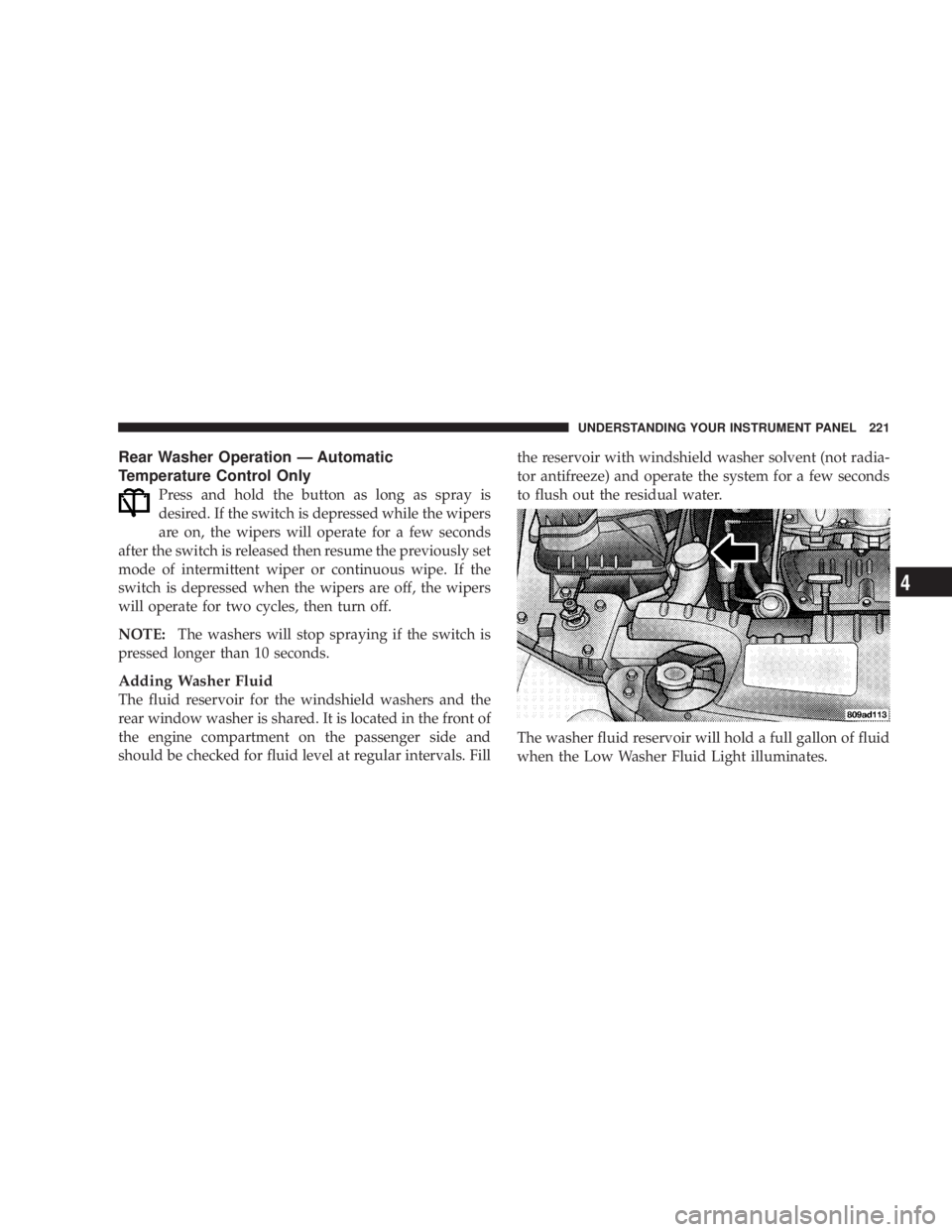
Rear Washer Operation Ð Automatic
Temperature Control Only
Press and hold the button as long as spray is
desired. If the switch is depressed while the wipers
are on, the wipers will operate for a few seconds
after the switch is released then resume the previously set
mode of intermittent wiper or continuous wipe. If the
switch is depressed when the wipers are off, the wipers
will operate for two cycles, then turn off.
NOTE: The washers will stop spraying if the switch is
pressed longer than 10 seconds.
Adding Washer Fluid
The fluid reservoir for the windshield washers and the
rear window washer is shared. It is located in the front of
the engine compartment on the passenger side and
should be checked for fluid level at regular intervals. Fill the reservoir with windshield washer solvent (not radia-
tor antifreeze) and operate the system for a few seconds
to flush out the residual water.
The washer fluid reservoir will hold a full gallon of fluid
when the Low Washer Fluid Light illuminates. UNDERSTANDING YOUR INSTRUMENT PANEL 221
4
Page 222 of 397
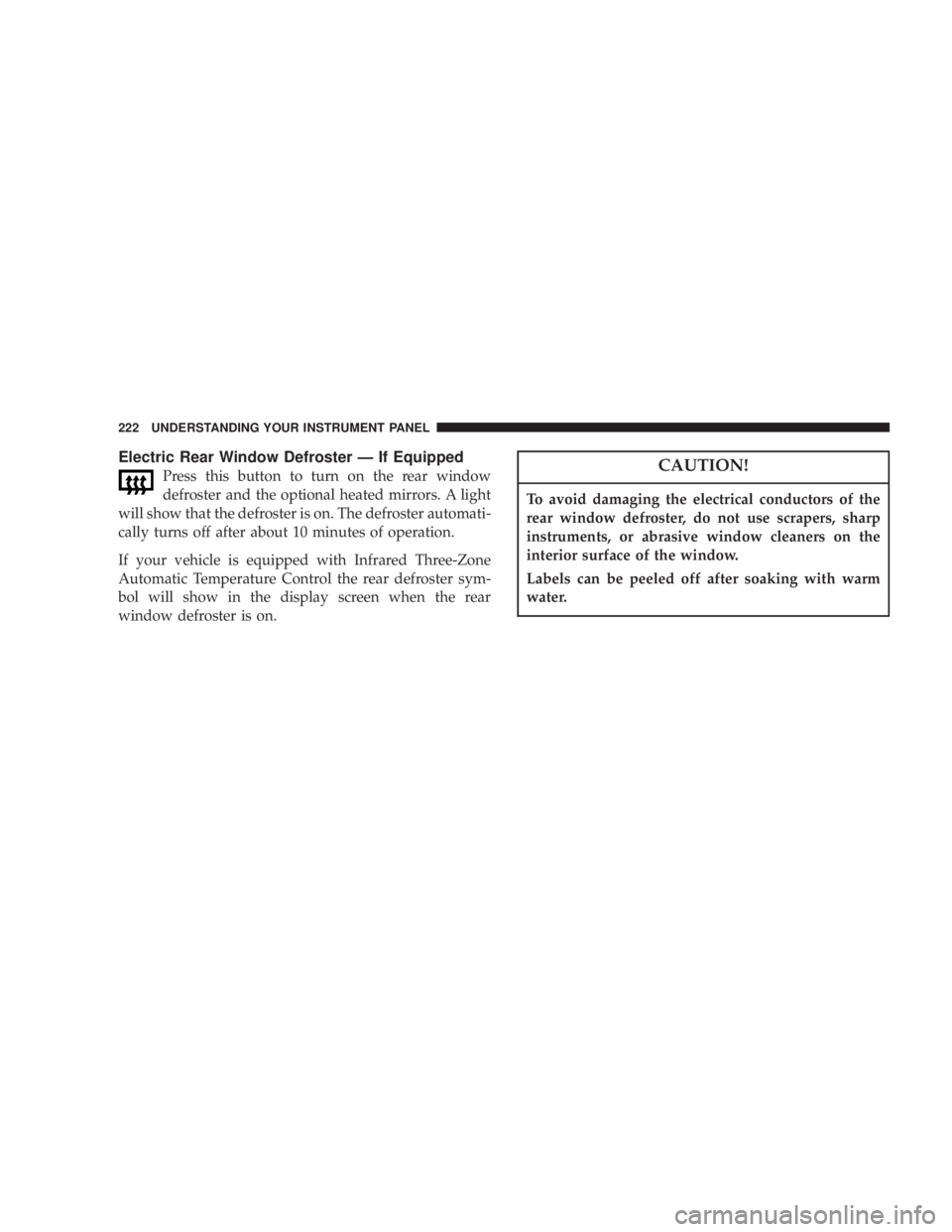
Electric Rear Window Defroster Ð If Equipped
Press this button to turn on the rear window
defroster and the optional heated mirrors. A light
will show that the defroster is on. The defroster automati-
cally turns off after about 10 minutes of operation.
If your vehicle is equipped with Infrared Three-Zone
Automatic Temperature Control the rear defroster sym-
bol will show in the display screen when the rear
window defroster is on. CAUTION!To avoid damaging the electrical conductors of the
rear window defroster, do not use scrapers, sharp
instruments, or abrasive window cleaners on the
interior surface of the window.
Labels can be peeled off after soaking with warm
water.222 UNDERSTANDING YOUR INSTRUMENT PANEL
Page 223 of 397
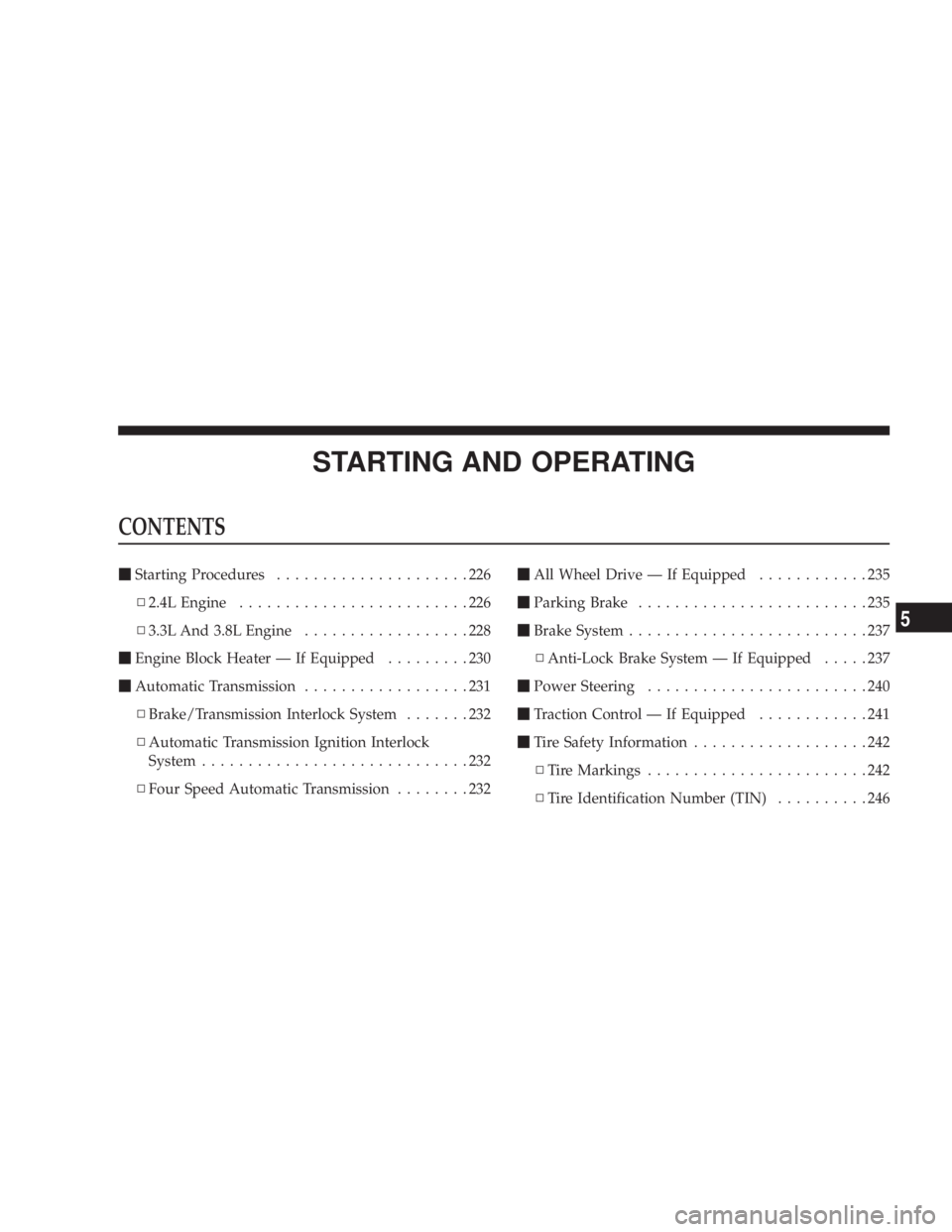
STARTING AND OPERATINGCONTENTS m Starting Procedures .....................226
N 2.4L Engine .........................226
N 3.3L And 3.8L Engine ..................228
m Engine Block Heater Ð If Equipped .........230
m Automatic Transmission ..................231
N Brake/Transmission Interlock System .......232
N Automatic Transmission Ignition Interlock
System .............................232
N Four Speed Automatic Transmission ........232 m All Wheel Drive Ð If Equipped ............235
m Parking Brake .........................235
m Brake System ..........................237
N Anti-Lock Brake System Ð If Equipped .....237
m Power Steering ........................240
m Traction Control Ð If Equipped ............241
m Tire Safety Information ...................242
N Tire Markings ........................242
N Tire Identification Number (TIN) ..........2465
Page 224 of 397
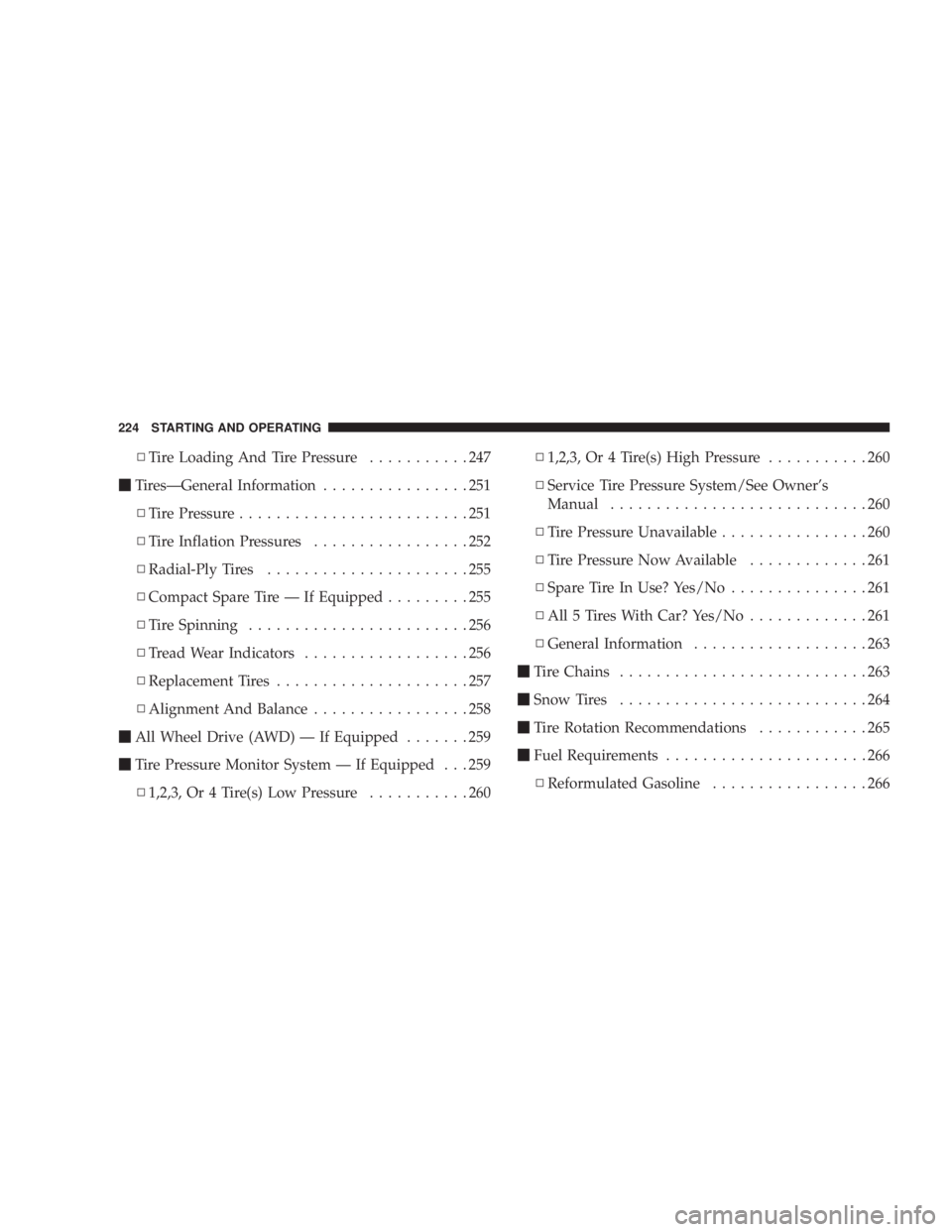
N Tire Loading And Tire Pressure ...........247
m TiresÐGeneral Information ................251
N Tire Pressure .........................251
N Tire Inflation Pressures .................252
N Radial-Ply Tires ......................255
N Compact Spare Tire Ð If Equipped .........255
N Tire Spinning ........................256
N Tread Wear Indicators ..................256
N Replacement Tires .....................257
N Alignment And Balance .................258
m All Wheel Drive (AWD) Ð If Equipped .......259
m Tire Pressure Monitor System Ð If Equipped . . . 259
N 1,2,3, Or 4 Tire(s) Low Pressure ...........260 N 1,2,3, Or 4 Tire(s) High Pressure ...........260
N Service Tire Pressure System/See Owner's
Manual ............................260
N Tire Pressure Unavailable ................260
N Tire Pressure Now Available .............261
N Spare Tire In Use? Yes/No ...............261
N All 5 Tires With Car? Yes/No .............261
N General Information ...................263
m Tire Chains ...........................263
m Snow Tires ...........................264
m Tire Rotation Recommendations ............265
m Fuel Requirements ......................266
N Reformulated Gasoline .................266224 STARTING AND OPERATING
Page 225 of 397
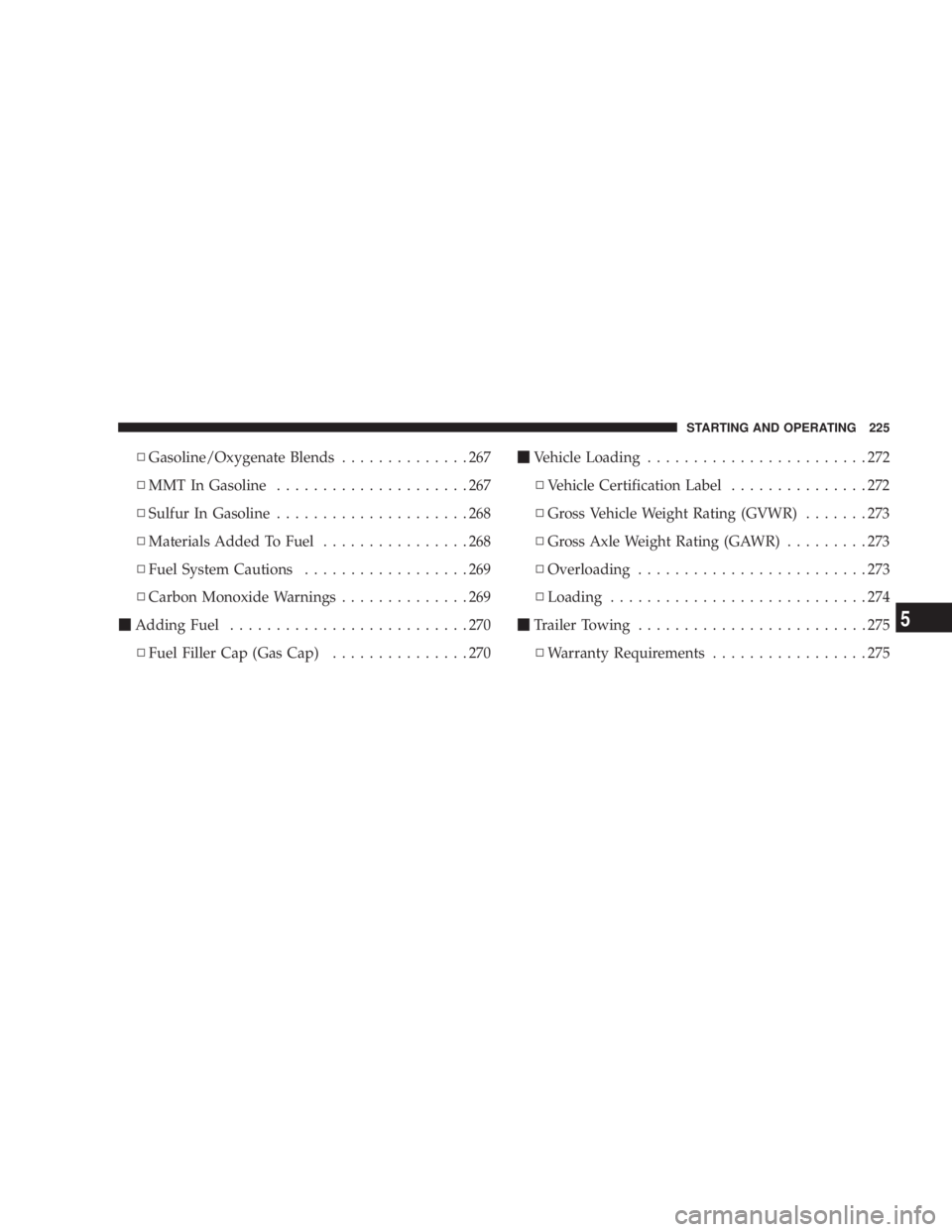
N Gasoline/Oxygenate Blends ..............267
N MMT In Gasoline .....................267
N Sulfur In Gasoline .....................268
N Materials Added To Fuel ................268
N Fuel System Cautions ..................269
N Carbon Monoxide Warnings ..............269
m Adding Fuel ..........................270
N Fuel Filler Cap (Gas Cap) ...............270 m Vehicle Loading ........................272
N Vehicle Certification Label ...............272
N Gross Vehicle Weight Rating (GVWR) .......273
N Gross Axle Weight Rating (GAWR) .........273
N Overloading .........................273
N Loading ............................274
m Trailer Towing .........................275
N Warranty Requirements .................275 STARTING AND OPERATING 225
5
Page 226 of 397
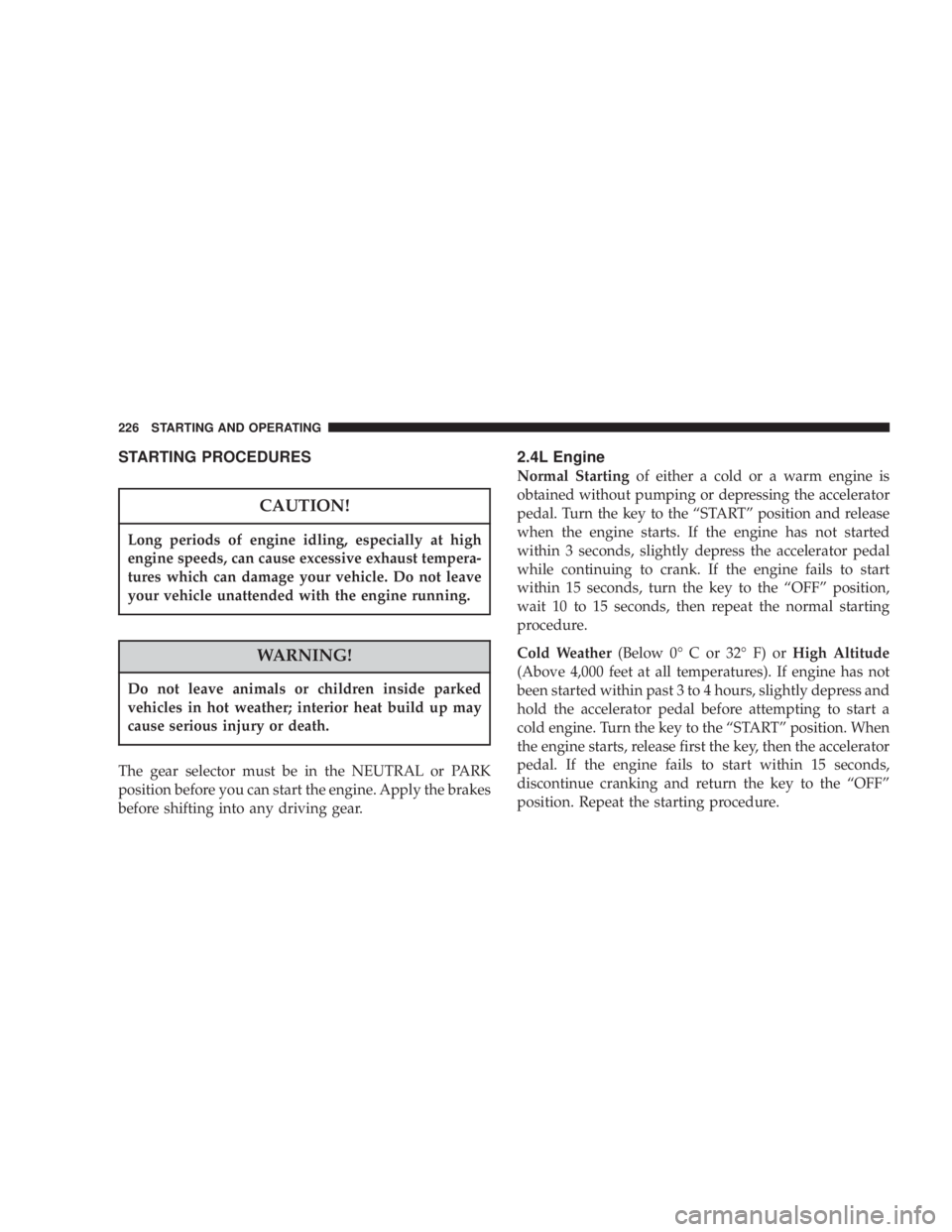
STARTING PROCEDURES
CAUTION!Long periods of engine idling, especially at high
engine speeds, can cause excessive exhaust tempera-
tures which can damage your vehicle. Do not leave
your vehicle unattended with the engine running.
WARNING!Do not leave animals or children inside parked
vehicles in hot weather; interior heat build up may
cause serious injury or death.
The gear selector must be in the NEUTRAL or PARK
position before you can start the engine. Apply the brakes
before shifting into any driving gear. 2.4L Engine
Normal Starting of either a cold or a warm engine is
obtained without pumping or depressing the accelerator
pedal. Turn the key to the ªSTARTº position and release
when the engine starts. If the engine has not started
within 3 seconds, slightly depress the accelerator pedal
while continuing to crank. If the engine fails to start
within 15 seconds, turn the key to the ªOFFº position,
wait 10 to 15 seconds, then repeat the normal starting
procedure.
Cold Weather (Below 0É C or 32É F) or High Altitude
(Above 4,000 feet at all temperatures). If engine has not
been started within past 3 to 4 hours, slightly depress and
hold the accelerator pedal before attempting to start a
cold engine. Turn the key to the ªSTARTº position. When
the engine starts, release first the key, then the accelerator
pedal. If the engine fails to start within 15 seconds,
discontinue cranking and return the key to the ªOFFº
position. Repeat the starting procedure.226 STARTING AND OPERATING
Page 227 of 397
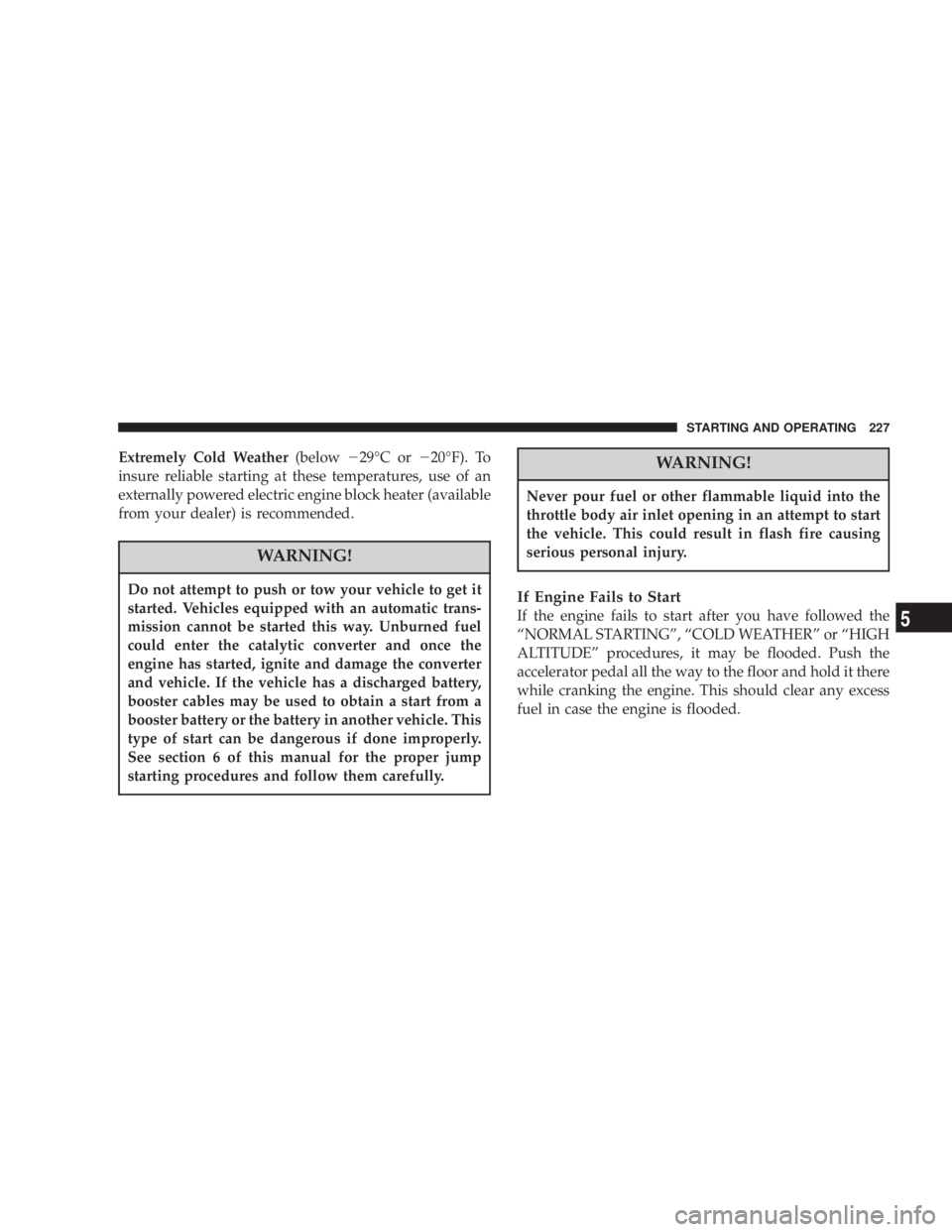
Extremely Cold Weather (below 2 29ÉC or 2 20ÉF). To
insure reliable starting at these temperatures, use of an
externally powered electric engine block heater (available
from your dealer) is recommended.
WARNING!Do not attempt to push or tow your vehicle to get it
started. Vehicles equipped with an automatic trans-
mission cannot be started this way. Unburned fuel
could enter the catalytic converter and once the
engine has started, ignite and damage the converter
and vehicle. If the vehicle has a discharged battery,
booster cables may be used to obtain a start from a
booster battery or the battery in another vehicle. This
type of start can be dangerous if done improperly.
See section 6 of this manual for the proper jump
starting procedures and follow them carefully. WARNING!Never pour fuel or other flammable liquid into the
throttle body air inlet opening in an attempt to start
the vehicle. This could result in flash fire causing
serious personal injury.
If Engine Fails to Start
If the engine fails to start after you have followed the
ªNORMAL STARTINGº, ªCOLD WEATHERº or ªHIGH
ALTITUDEº procedures, it may be flooded. Push the
accelerator pedal all the way to the floor and hold it there
while cranking the engine. This should clear any excess
fuel in case the engine is flooded. STARTING AND OPERATING 227
5
Page 228 of 397
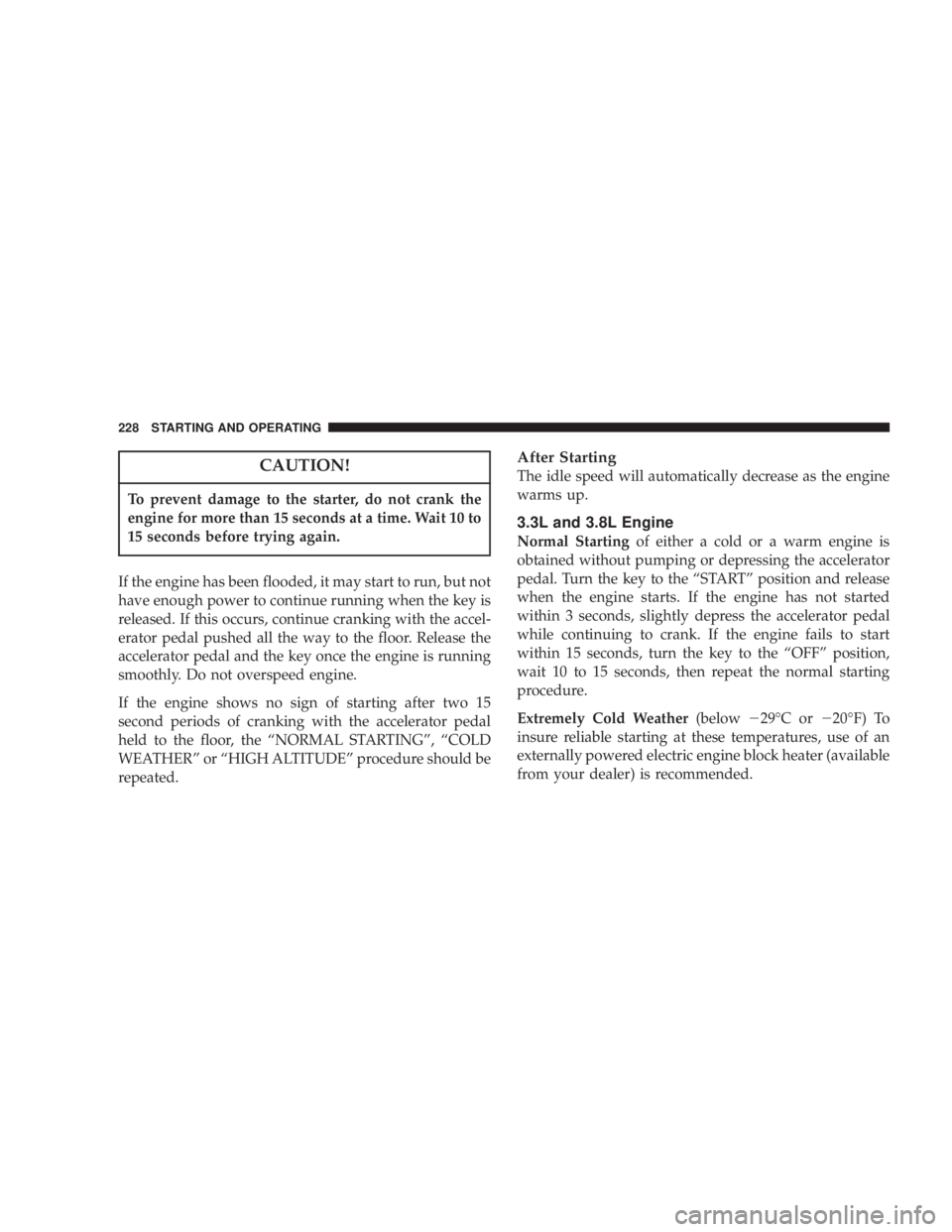
CAUTION!To prevent damage to the starter, do not crank the
engine for more than 15 seconds at a time. Wait 10 to
15 seconds before trying again.
If the engine has been flooded, it may start to run, but not
have enough power to continue running when the key is
released. If this occurs, continue cranking with the accel-
erator pedal pushed all the way to the floor. Release the
accelerator pedal and the key once the engine is running
smoothly. Do not overspeed engine.
If the engine shows no sign of starting after two 15
second periods of cranking with the accelerator pedal
held to the floor, the ªNORMAL STARTINGº, ªCOLD
WEATHERº or ªHIGH ALTITUDEº procedure should be
repeated. After Starting
The idle speed will automatically decrease as the engine
warms up.
3.3L and 3.8L Engine
Normal Starting of either a cold or a warm engine is
obtained without pumping or depressing the accelerator
pedal. Turn the key to the ªSTARTº position and release
when the engine starts. If the engine has not started
within 3 seconds, slightly depress the accelerator pedal
while continuing to crank. If the engine fails to start
within 15 seconds, turn the key to the ªOFFº position,
wait 10 to 15 seconds, then repeat the normal starting
procedure.
Extremely Cold Weather (below 2 29ÉC or 2 20ÉF) To
insure reliable starting at these temperatures, use of an
externally powered electric engine block heater (available
from your dealer) is recommended.228 STARTING AND OPERATING
Page 229 of 397
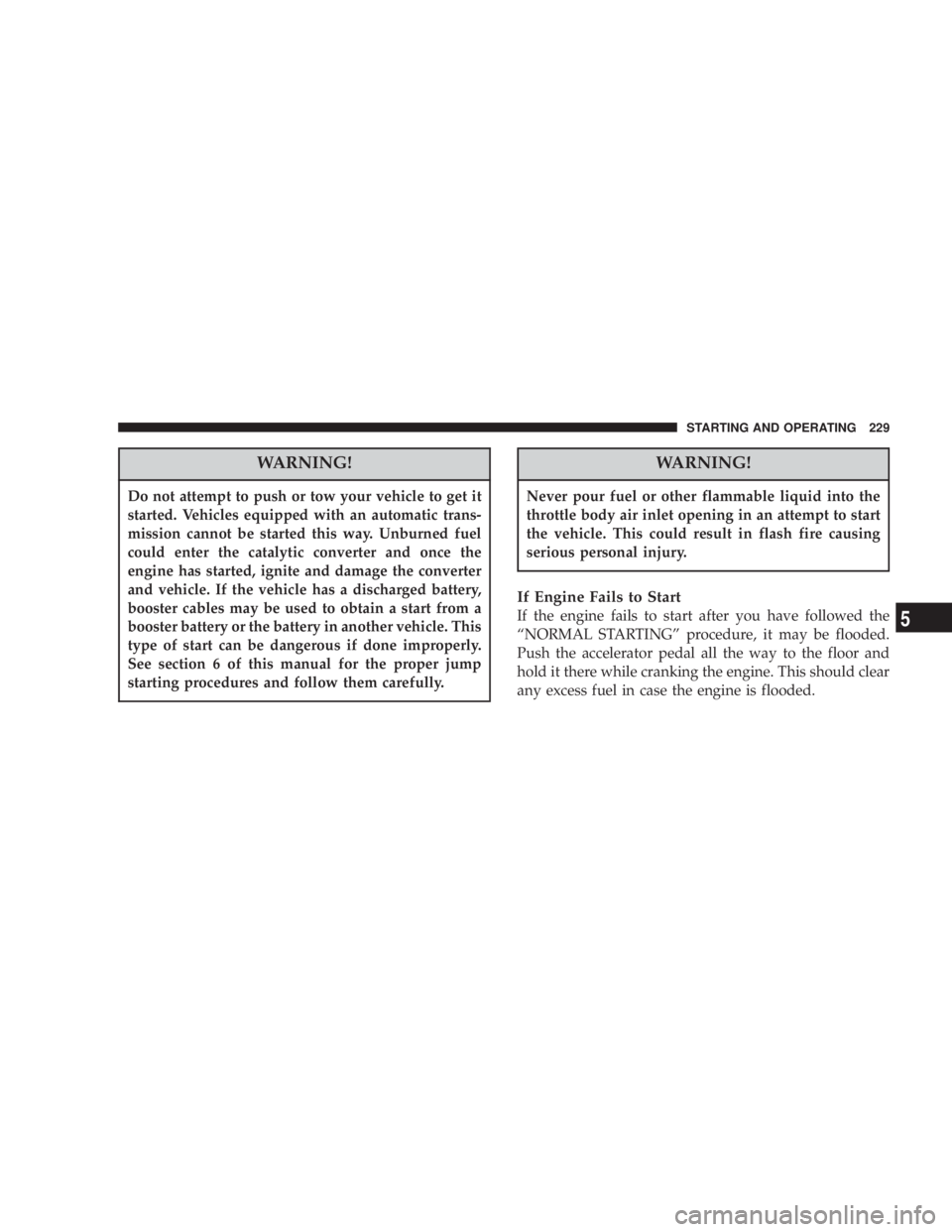
WARNING!Do not attempt to push or tow your vehicle to get it
started. Vehicles equipped with an automatic trans-
mission cannot be started this way. Unburned fuel
could enter the catalytic converter and once the
engine has started, ignite and damage the converter
and vehicle. If the vehicle has a discharged battery,
booster cables may be used to obtain a start from a
booster battery or the battery in another vehicle. This
type of start can be dangerous if done improperly.
See section 6 of this manual for the proper jump
starting procedures and follow them carefully. WARNING!Never pour fuel or other flammable liquid into the
throttle body air inlet opening in an attempt to start
the vehicle. This could result in flash fire causing
serious personal injury.
If Engine Fails to Start
If the engine fails to start after you have followed the
ªNORMAL STARTINGº procedure, it may be flooded.
Push the accelerator pedal all the way to the floor and
hold it there while cranking the engine. This should clear
any excess fuel in case the engine is flooded. STARTING AND OPERATING 229
5
Page 230 of 397
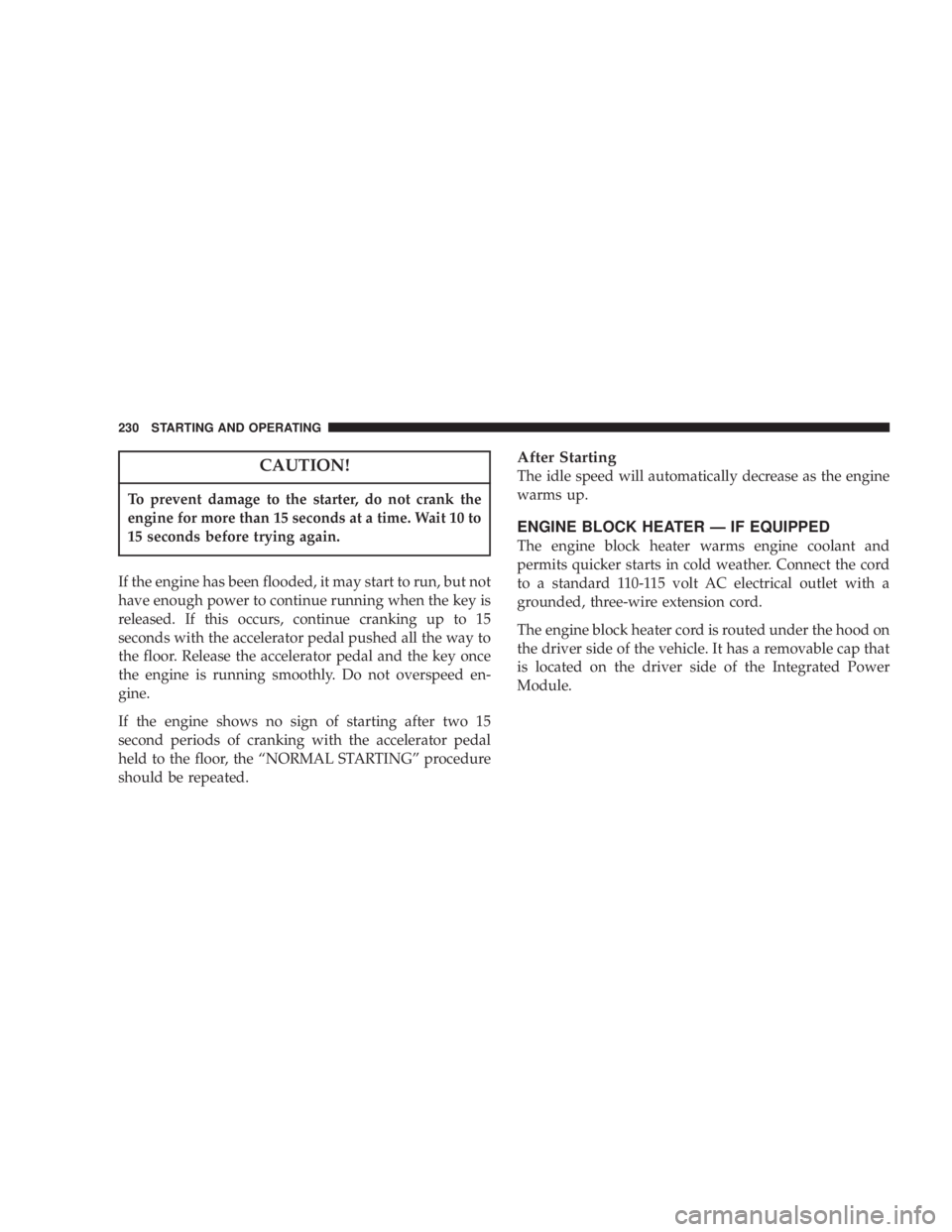
CAUTION!To prevent damage to the starter, do not crank the
engine for more than 15 seconds at a time. Wait 10 to
15 seconds before trying again.
If the engine has been flooded, it may start to run, but not
have enough power to continue running when the key is
released. If this occurs, continue cranking up to 15
seconds with the accelerator pedal pushed all the way to
the floor. Release the accelerator pedal and the key once
the engine is running smoothly. Do not overspeed en-
gine.
If the engine shows no sign of starting after two 15
second periods of cranking with the accelerator pedal
held to the floor, the ªNORMAL STARTINGº procedure
should be repeated. After Starting
The idle speed will automatically decrease as the engine
warms up.
ENGINE BLOCK HEATER Ð IF EQUIPPED
The engine block heater warms engine coolant and
permits quicker starts in cold weather. Connect the cord
to a standard 110-115 volt AC electrical outlet with a
grounded, three-wire extension cord.
The engine block heater cord is routed under the hood on
the driver side of the vehicle. It has a removable cap that
is located on the driver side of the Integrated Power
Module.230 STARTING AND OPERATING